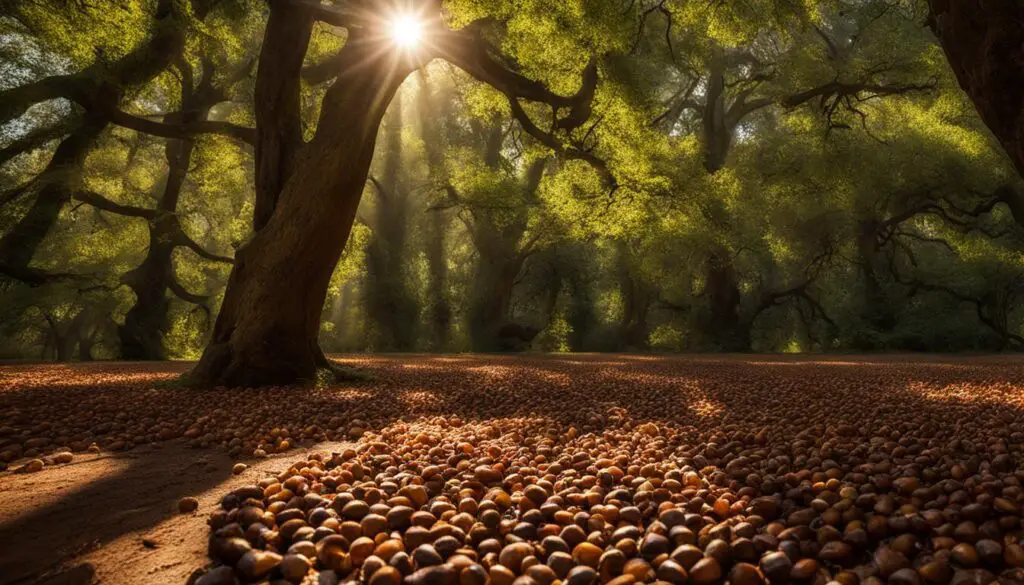Oak trees have a unique reproductive cycle, where they produce acorns as their fruit. This process, known as a mast year, occurs every 2 to 5 years. During a mast year, oak trees produce a high yield of acorns, while in other years, the yield may be lower. The exact reasons for mast years are still uncertain, but they are considered a defensive mechanism for oaks to ensure the survival of their offspring.
Acorns typically mature in late summer and start falling from the trees in September or October, with variations depending on the region. Acorn dropping may continue until November or December, but the majority of acorns are usually dropped by Christmas.
Key Takeaways:
- Oak trees go through a reproductive cycle known as a mast year, where they produce a high yield of acorns every 2 to 5 years.
- Acorns typically mature in late summer, with the majority of them falling from the trees between September to December.
- The exact reasons for mast years are still uncertain, but they are believed to be a defensive mechanism for oak trees.
- Understanding the acorn dropping timeline can help in predicting when to expect acorns from oak trees.
- Mast years ensure the survival and dispersal of oak tree offspring.
Understanding Mast Years and Acorn Production
Oak trees, known for their majestic presence and longevity, go through cycles of high and low acorn yields. These cycles, commonly referred to as mast years, are fascinating phenomena that impact the abundance of acorns produced by oak trees. During mast years, oak trees exhibit a remarkable increase in acorn production compared to off years.
The factors that trigger mast years are not yet fully understood, but several elements may contribute to this irregular pattern. Climate conditions, such as temperature and rainfall, play a role in the reproductive cycle of oak trees and influence the quantity of acorns produced. Additionally, pollination and seed development processes play a crucial part in determining the acorn yield during mast years.
The reproductive cycle of oak trees begins around 20 years of age, when they start producing acorns. The production of acorns steadily increases, reaching its peak between the ages of 50 and 80. However, after 80 years, the oak trees’ acorn production starts to decline gradually. Understanding these age-related patterns provides valuable insights into the reproductive lifespan of oak trees and their acorn production capabilities.
The Importance of Mast Years for Oak Trees and Wildlife
Mast years play a vital role in the life cycle of oak trees and have a significant impact on wildlife. These unique years, characterized by an abundant acorn production, provide a valuable food source for a variety of animals, including squirrels, mice, birds, and other forest frugivores. The consumption of acorns by wildlife is crucial for their survival, as it provides essential nutrients and sustenance.
During mast years, oak trees allocate a substantial amount of energy towards producing a bountiful harvest of acorns. This energy allocation, however, can result in subsequent years of low or no acorn yield as the trees recover. The fluctuation in food availability due to mast years can influence wildlife populations, leading to adjustments in their feeding habits and potential population declines during years of low acorn production.
Despite this potential short-term impact, mast years serve a crucial long-term purpose for both oak trees and the ecosystem. The surplus of acorns in mast years increases the chances of successful germination and growth of oak tree offspring. Animals play a significant role in this process by consuming a portion of the acorns and inadvertently dispersing them through their behaviors, such as burying them for later consumption.
To illustrate the importance of mast years for oak trees and wildlife, consider the following table:
| Wildlife | Food Source |
|---|---|
| Squirrels | Acorns are a staple food source for squirrels, providing essential fats and proteins. |
| Mice | Mice rely on acorns as a primary food source, especially during times of scarcity. |
| Birds | Acorns are an important dietary component for many bird species, offering them energy and nutrients. |
| Other Forest Frugivores | A wide range of forest frugivores, such as deer, bears, and wild boars, benefit from the abundance of acorns during mast years. |
The interaction between oak trees and wildlife during mast years demonstrates the intricate ecological relationships and dependencies that exist within forest ecosystems. Oak trees rely on animals to disperse their seeds, ensuring the survival and propagation of future generations. In turn, wildlife depend on acorns as a reliable food source, supporting their energy needs and promoting their overall well-being.

The image above showcases the diverse wildlife species that benefit from the abundant acorn production during mast years. The balance between oak trees and wildlife is crucial for maintaining the health and biodiversity of forest ecosystems.
Factors Influencing Oak Tree Acorn Production
The exact factors that influence oak tree acorn production during mast years are still uncertain. However, researchers have proposed several theories regarding the impact of climate conditions on acorn development. Temperature and rainfall play crucial roles in determining the success of acorn production.
During harsh summers, extreme temperatures can affect the pollination process and disrupt the availability of spring winds, potentially leading to either higher or lower acorn yields. The fluctuation in temperature and rainfall patterns can disturb the delicate balance required for optimal acorn production.
The evolutionary benefits of mast years for oak trees cannot be understated. These cyclic patterns of high and low acorn yields ensure the survival and dispersal of their offspring, promoting genetic diversity and enhancing the species’ adaptability to changing environments.
The influence of climate on oak tree acorn production is a subject of ongoing research, with scientists striving to unravel the complex interplay between environmental factors and reproductive cycles. Understanding these mechanisms can help us appreciate the remarkable adaptations of oak trees and their essential role in forest ecosystems.
No Correlation Between Mast Years and Winter Severity
Contrary to popular folklore, there is no direct correlation between mast years and the severity of winters. Despite the abundance of acorns in a particular year, it does not reliably predict the intensity or mildness of the following winter. The cycle of mast years, where oak trees produce a high yield of acorns, occurs every 2 to 5 years, independent of winter conditions. It is important to understand that the natural reproductive cycle of oak trees aims to maintain future generations, without any influence from winter severity or predictions.
The folklore surrounding the connection between acorn abundance and winter predictions has been prevalent in many cultures. However, scientific research indicates that factors other than acorns, such as atmospheric and climatic patterns, play a more significant role in determining winter severity. While acorns provide a valuable food source for wildlife during the winter months, their abundance is not indicative of the winter ahead.
To further emphasize this point, several studies have investigated the relationship between acorn production and winter conditions. These studies have consistently found no correlation between the two variables. Winter severity can vary greatly from year to year, depending on complex atmospheric and climatic interactions that extend beyond acorn production.

It is important to remember that mast years and winter severity are independent phenomena. The cycle of mast years is a natural occurrence in the reproductive cycle of oak trees, aimed at ensuring the survival and dispersal of their offspring. Winter severity, on the other hand, is driven by a multitude of factors that extend far beyond the abundance or scarcity of acorns.
Understanding this lack of correlation helps dispel the myth that the presence of a bountiful acorn harvest signifies a harsh winter ahead. It is merely the normal and periodic cycle of oak trees, unaffected by winter conditions. So while the sight of abundant acorns may evoke thoughts of a cold and snowy winter, it is important to separate fact from folklore and appreciate the true nature of these natural processes.
Individual Oak Tree Cycles and Acorn Dropping
Each oak tree follows its own cycle when it comes to acorn production and dropping. Just because one oak tree is producing a significant number of acorns does not mean that neighboring oaks will have the same yield. Factors such as age, health, and environmental conditions can influence an individual oak tree’s acorn production and dropping timeline. It is essential to understand that acorn dropping can vary even among nearby oak trees.
As with any living organism, oak trees are influenced by multiple factors that shape their growth and reproduction. These factors can result in variation in acorn production and dropping within a population of oak trees. While some may produce a large number of acorns in a particular year, others may have a lower yield or even no acorns at all. This natural variation is a result of the complex interactions between the tree’s genetics, environmental conditions, and physiological health.
The age of an oak tree is a crucial factor in its acorn production. Mature trees between 50 and 80 years old generally have the highest acorn yields, while younger or older trees may produce fewer acorns. Environmental conditions, such as temperature, precipitation, and sunlight, also play a significant role. A healthy oak tree growing in an optimal environment is more likely to have a bountiful acorn crop compared to a stressed or weakened tree.
In addition to age and environmental factors, other variables can affect an oak tree’s acorn production. These variables include pollination success, competition for resources, and tree-to-tree variations in genetic traits. Each oak tree possesses unique genetic characteristics, resulting in individual variations in acorn production and dropping patterns. These variations contribute to the overall resilience and diversity of oak tree populations.
The table below provides a comparison of acorn dropping patterns for three different oak trees. It highlights the variability in acorn production and dropping among these individual trees:
| Oak Tree | Acorn Production | Acorn Dropping |
|---|---|---|
| Tree A | High | September-November |
| Tree B | Low | October-December |
| Tree C | No yield | N/A |
Table: Comparison of Acorn Dropping Patterns for Individual Oak Trees
This table demonstrates how individual oak trees can exhibit different acorn production levels and dropping timelines. While Tree A has a high yield and drops acorns from September to November, Tree B has a lower yield and drops acorns from October to December. On the other hand, Tree C does not produce any acorns during that particular year. These variations further emphasize the importance of considering individual oak tree cycles when studying acorn production and dropping patterns.
Understanding individual oak tree cycles and the variation in acorn dropping is crucial for researchers, ecologists, and forest managers. By examining the factors influencing this variation, scientists can gain a deeper understanding of oak tree reproductive strategies and the overall dynamics of oak forest ecosystems.
Harvesting Season and Duration of Acorn Dropping
The acorn harvesting season is an eagerly anticipated time for nature enthusiasts and wildlife alike. It typically begins in late summer when oak trees start to drop their acorns. The exact timing may vary based on the region, with some areas experiencing acorn dropping as early as August or as late as November or December. However, for the majority of regions, the acorn season kicks off in September or October.
By Christmas, the majority of acorns have usually fallen from the trees, signaling the end of the acorn dropping season. During this time, the forest floor becomes adorned with a bountiful carpet of acorns, providing a valuable food source for various animals.
The duration of acorn falling can be influenced by several factors, including the species of oak tree, environmental conditions, and the individual tree’s cycle. While some oak trees may drop their acorns over a few weeks, others may span several months. Additionally, variations in climate patterns or the health of the tree can also affect the length of the acorn dropping season.
The acorn harvesting season not only supports the survival of wildlife but also presents opportunities for horticultural enthusiasts and craftspeople who utilize acorns in various projects. Let’s take a closer look at the impact and benefits of this remarkable season.

Uses and Benefits of Acorns
Acorns play a vital role as a food source for many animals, including squirrels, deer, and birds, thanks to their high nutritional content. However, it’s important to note that raw acorns contain tannins, which give them a bitter taste and can hinder nutrient absorption.
To make acorns suitable for human consumption, they must undergo a process to remove the tannins. This can be done through various methods, such as soaking, boiling, or leaching. Once the tannins are removed, acorns can be used as an ingredient in a variety of dishes.
Aside from being a food source, acorns have numerous other applications. For example, they can be used as a natural dye for fabrics and yarn, producing earthy and vibrant shades. Acorns can also be ground into flour, which can be used in baking to add a nutty flavor and unique texture to bread, cookies, and other baked goods.
Furthermore, the high nutrient content in acorns makes them an excellent natural fertilizer. They provide essential elements like nitrogen, potassium, and phosphorus, which promote healthy growth and nutrient-rich soil.
Overall, the versatility of acorns makes them valuable resources in various domains, ranging from food to craft and agriculture. Their usage offers a sustainable and eco-friendly alternative that taps into the abundance of nature’s offerings.

Conclusion
Oak trees go through a reproductive cycle known as mast years, where they produce acorns every 2 to 5 years. These mast years are crucial for the survival and dispersal of oak tree offspring, ensuring the continuation of their species. The process begins in late summer when the acorns mature, and they start falling from the trees in late September or October, depending on the region.
The dropping of acorns continues until November or December, with the majority typically dropped by Christmas. It is important to note that each oak tree follows its own cycle of acorn production and dropping, which can be influenced by factors such as climate, age, and health. This individual variation adds to the complexity and diversity of oak tree populations.
Acorns play a vital role in the ecosystem as they serve as an important food source for wildlife. Squirrels, mice, birds, and other forest frugivores rely on acorns for their nutrition and energy needs. Additionally, acorns can be utilized by humans in various ways, such as dyeing fabrics and yarn, producing flour for baking, and even as a natural source of fertilizer.
Understanding the acorn season and its significance deepens our appreciation for the natural cycles of oak trees and the ecosystem they support. By recognizing the importance of mast years, we can gain a greater understanding of the intricate relationships between oak trees, wildlife, and the environment, fostering a deeper connection and respect for nature’s wonders.
FAQ
When do oak trees drop acorns?
Oak trees typically start dropping acorns in late September or October, with variations depending on the region. The majority of acorns are usually dropped by Christmas.
What is a mast year?
A mast year is a reproductive cycle of oak trees where they produce a high yield of acorns. This cycle occurs every 2 to 5 years.
Why do oak trees have mast years?
The exact reasons for mast years are uncertain, but they are considered a defensive mechanism to ensure the survival and dispersal of oak tree offspring.
What factors influence oak tree acorn production?
Factors such as climate conditions (temperature and rainfall), pollination processes, and seed development can influence oak tree acorn production.
Do mast years predict the severity of winters?
No, mast years have no direct correlation with the severity or mildness of winters. They are a natural reproductive cycle of oak trees.
Do neighboring oak trees have the same acorn yield during mast years?
Each oak tree follows its own cycle of acorn production and dropping, so neighboring trees may have different acorn yields.
When is the acorn harvesting season?
The acorn harvesting season typically begins in late summer, with acorns starting to fall from oak trees in September or October.
How long does the acorn dropping season last?
The duration of acorn dropping can vary, but the majority of acorns are usually dropped by Christmas. Acorn dropping may continue until November or December.
What are the uses of acorns?
Acorns can be utilized in various ways, including dyeing fabrics and yarn, producing flour for baking, and even as a natural source of fertilizer.

